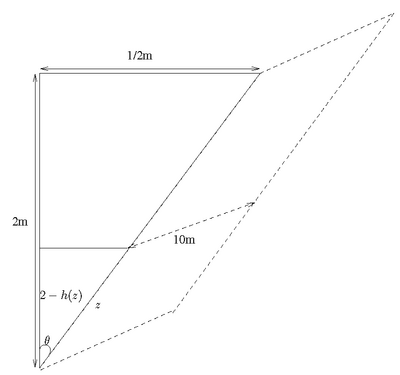Science:Math Exam Resources/Courses/MATH101/April 2009/Question 07 (c)/Solution 1
Hydrostatic Force was not covered in the 2012 offering of this course. Time might better be spent solving other problems given how soon the exam is coming.
Consider the rectangular side picture right.
We will define the coordinate along with width of the rectangle as z. Consider a thin rectangle at a fixed z with length 10 (as pictured). The hydrostatic force on this rectangle is,
Notice that the depth here is a function of z since each little rectangle will correspond to a different depth in the tank. To determine the depth as a function of z consider the side view of the rectangular side where the width is actually the side of a triangle (pictured left)
. We have only draw half of the triangle to highlight that we can use right triangle trigonometry. We know that the height of this triangle is 2 and the length is 1/2 (half of the base of the full triangle). From the diagram, we define to be the angle between the vertical line and the hypotenuse and we have that
Recall that the variable z indicates the distance along the hypotenuse. For a given z we can get the vertical length of the corresponding right triangle, y, as
Therefore we have that
which we can substitute into our hydrostatic force to get,
Now z starts at the bottom of the rectangle (which we will define as z=0) and ends at the full length of the triangular side. We can use Pythagorean theorem to get that the full length of that side is . Therefore we have that the hydrostatic force is,
Since we are asked to set up the integral but not evaluate it, we are now done.









